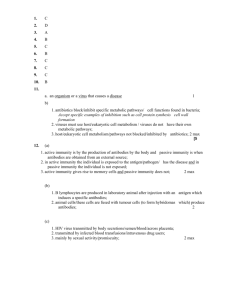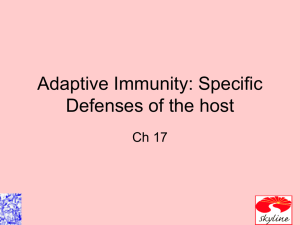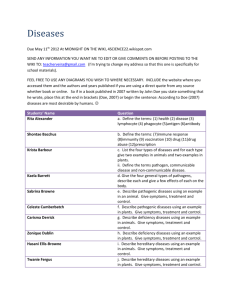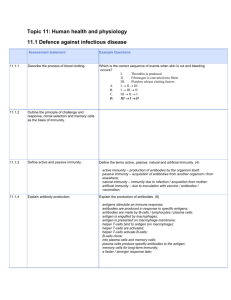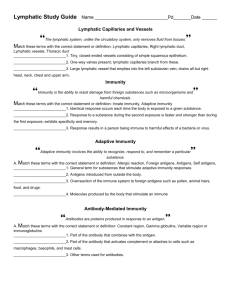unit 4 review
advertisement
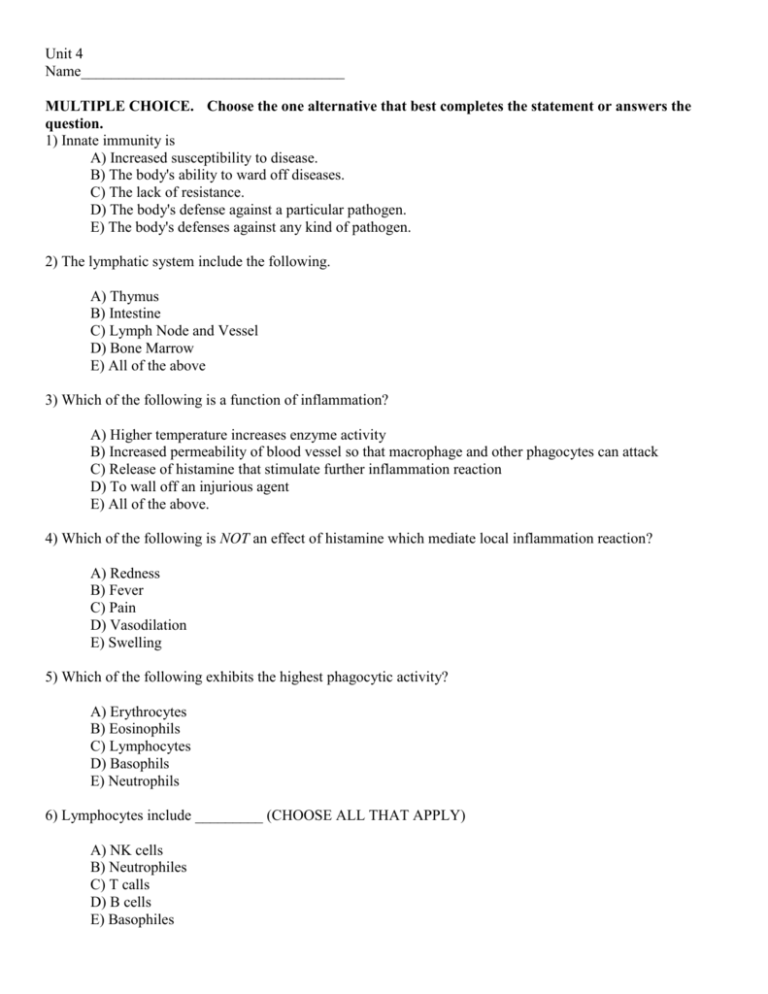
Unit 4 Name___________________________________ MULTIPLE CHOICE. Choose the one alternative that best completes the statement or answers the question. 1) Innate immunity is A) Increased susceptibility to disease. B) The body's ability to ward off diseases. C) The lack of resistance. D) The body's defense against a particular pathogen. E) The body's defenses against any kind of pathogen. 2) The lymphatic system include the following. A) Thymus B) Intestine C) Lymph Node and Vessel D) Bone Marrow E) All of the above 3) Which of the following is a function of inflammation? A) Higher temperature increases enzyme activity B) Increased permeability of blood vessel so that macrophage and other phagocytes can attack C) Release of histamine that stimulate further inflammation reaction D) To wall off an injurious agent E) All of the above. 4) Which of the following is NOT an effect of histamine which mediate local inflammation reaction? A) Redness B) Fever C) Pain D) Vasodilation E) Swelling 5) Which of the following exhibits the highest phagocytic activity? A) Erythrocytes B) Eosinophils C) Lymphocytes D) Basophils E) Neutrophils 6) Lymphocytes include _________ (CHOOSE ALL THAT APPLY) A) NK cells B) Neutrophiles C) T calls D) B cells E) Basophiles 7) Macrophages arise from which of the following? A) Lymphocyte B) Monocyte C) Neutrophil D) Basophil E) Eosinophil 8) What type of immunity results from vaccination? A) Innate immunity B) Naturally acquired active immunity C) Naturally acquired passive immunity D) Artificially acquired active immunity E) Artificially acquired passive immunity 9) What type of immunity results from transfer of antibodies from one individual to a susceptible individual by means of injection? A) Innate immunity B) Naturally acquired active immunity C) Naturally acquired passive immunity D) Artificially acquired active immunity E) Artificially acquired passive immunity 10) What type of immunity results from recovery from mumps? A) Innate immunity B) Naturally acquired active immunity C) Naturally acquired passive immunity D) Artificially acquired active immunity E) Artificially acquired passive immunity 11) Newborns' immunity due to the transfer of antibodies across the placenta is an example of A) Innate immunity. B) Naturally acquired active immunity. C) Naturally acquired passive immunity. D) Artificially acquired active immunity. E) Artificially acquired passive immunity. 12) What type of immunity is NOT due to antibodies? A) Innate immunity B) Naturally acquired active immunity C) Naturally acquired passive immunity D) Artificially acquired active immunity E) Artificially acquired passive immunity 13) What type of immunity results from injection of tetanus toxoid? A) Innate immunity B) Naturally acquired active immunity C) Naturally acquired passive immunity D) Artificially acquired active immunity E) Artificially acquired passive immunity 14) Immunity due to injection of an antigen is an example of A) Innate immunity. B) Naturally acquired active immunity. C) Naturally acquired passive immunity. D) Artificially acquired active immunity. E) Artificially acquired passive immunity. 15) CD4+ T cells are activated by A) Complement. B) Interaction between TCR and processed Ag on the APC. C) Cytokines released by dendtritic cells. D) Cytokines released by B cells. E) Interaction between TCRs and MHC II. 16) Which of the following recognizes antigens displayed on host cells with MHC II? A) B cell B) cell C) cell D) Natural killer cell E) Basophil 17) The specificity of an antibody is due to A) The variable portions of the H and L chains. B) The H chains. C) The L chains. D) The constant portions of the H and L chains. E) Its valence. 18) Which of the following is NOT a characteristic of B cells? A) They recognize antigens associated with MHC I. B) They originate in bone marrow. C) They are responsible for antibody formation. D) They are responsible for the memory response. E) They have antibodies on their surfaces. 19) Which of the following is NOT a characteristic of cellular immunity? A) It can inhibit the immune response. B) Cells are processed in the thymus gland. C) The cells originate in bone marrow. D) T cells react with antigens. E) B cells make antibodies. 20) Plasma cells are activated by a(n) A) Memory cell. B) Antigen. C) T cell. D) B cell. 21) The antibodies found in mucus, saliva, and tears are A) IgG. B) IgM. C) IgA. D) IgD. E) IgE. 22) The antibodies found on B cells and initiate B cell activation are A) IgG. B) IgM. C) IgA. D) IgD. E) IgE. 23) The antibodies that can bind to large parasites are A) IgG. B) IgM. C) IgA. D) IgD. E) IgE. 24) In addition to IgG, the antibodies that can fix complement are A) IgG. B) IgM. C) IgA. D) IgD. E) IgE. D) IgD. E) IgE. 25) Large antibodies that agglutinate antigens are A) IgG. B) IgM. C) IgA. 26) The most abundant class of antibodies in serum is A) IgG. B) IgM. C) IgA. D) IgD. E) IgE. Figure 17.1 27) In Figure 17.1, which letter on the graph indicates the patient's secondary response to an antigen? A) a B) b C) c D) d E) e 28) In Figure 17.1, which letter on the graph indicates the patient's response to a second antigen? A) a B) b C) c D) d E) e 29) In Figure 17.1, the arrow at time (d) indicates A) Exposure to a new antigen. B) The secondary response. C) The time of exposure to the same antigen as at time (a). D) The primary response. E) The T-cell response. 30) Which statement is false? A) The variable region of a heavy chain binds with antigen. B) The constant region of a heavy chain is the same for all antibodies. C) The variable region of a light chain binds with antigen. D) The Fc region attaches to a host cell. 31) The best definition of antigen is A) A protein that combines with antibodies. B) Something foreign in the body. C) A chemical that combines with antibodies. D) A chemical that elicits an antibody response and can combine with these antibodies. E) A pathogen. 32) The best definition antibody is A) A protein made in response to an antigen that can combine with that antigen. B) A serum protein. C) An immunoglobulin. D) A protein that combines with a protein or carbohydrate. E) A protein that inactivates or kills an antigen. Figure 17.2 33) In Figure 17.2, which areas are similar for all IgG antibodies? A) a and b B) a and c C) b and c D) c and d E) b and d 34) In Figure 17.2, which areas represent antigen-binding sites? A) a and b B) a and c C) b and c D) c and d 35) In Figure 17.2, what can attach to a host cell? A) b and c B) a and c C) b D) d E) e E) b and d 36) Figure 17.2 could be any of the following EXCEPT A) IgE. B) IgM. C) IgG. D) IgD. E) The figure could represent any of the above. 37) The presence of which of the following indicates a current infection rather than a previous infection or vaccination? A) IgE B) IgG C) IgA D) IgD E) IgM 38) Which of the following destroys virus-infected cells? A) Treg B) B cells C) TH D) Dendritic cells E) CTL 39) Thymic selection A) Destroys T cells that don’t recognize self-molecules of MHC. B) Destroys B cells that make antibodies against self. C) Activates B cells. D) Destroys MHC molecules. E) Destroys CD4+ cells that attack self. 40) Which of the following statements about natural killer cells is true? A) They destroy cells lacking MHC I. B) They destroy virus-infected cells. C) They destroy tumor cells. D) All of the above statements are true. 41) A Treg cell deficiency could result in A) Increased number of viral infections. B) Transplant rejection. C) Autoimmunity. D) Increased severity of bacterial infections. E) Increased number of bacterial infections. 42) Which of the following statements about IL-12 is true? A) It activates macrophages. B) It causes TH cells to respond to HIV. C) It inhibits some tumor cells. D) It activates the TH1 pathway. E) All of the above. 43) TH cells A) Produce cytokines B) Function in B cell activation C) Produce interferon D) Are activated by APCs E) All of the above 44) Tc cells A) Have CD8+ on the surface B) Can become CTLs C) Can cause cell death D) Effective for fighting virus infected cells E) All of the above 45) Hypersensitivity is due to A) An altered immune response. B) Immunity. C) The presence of an antigen. D) Allergies. E) The presence of antibodies. 46) Which type of transplant is least compatible? A) Allograft B) Xenotransplant C) Isograft D) Autograft 47) A hypersensitivity reaction occurs A) During the first exposure to an antigen. B) In immunologically tolerant individuals. C) On a second or subsequent exposure to an antigen. D) In individuals with diseases of the immune system. E) During autoimmune diseases. 48) Which of the following statements about type I hypersensitivities are true? A) The symptoms are due to histamine. B) They involve IgE antibodies. C) The symptoms occur soon after exposure to an antigen. D) Antibodies are bound to host cells. E) All of the above. 49) Which of the following may be inherited or result from HIV infection? A) Immunosuppression B) Immunologic enhancement C) Immunotherapy D) Autoimmunity E) Immunologic surveillance 50) Treatment with certain drugs to reduce transplant rejection can cause A) Immunosuppression. B) Immunotherapy. C) Immunologic surveillance. D) Immunologic enhancement. E) Autoimmunity

